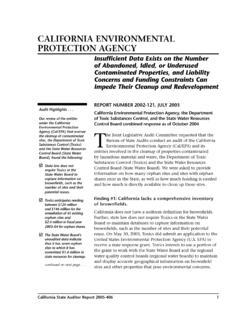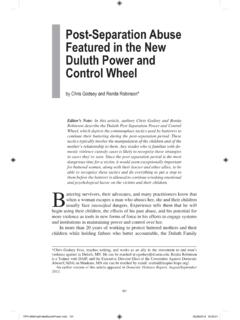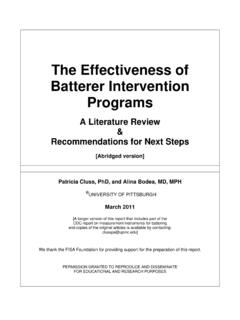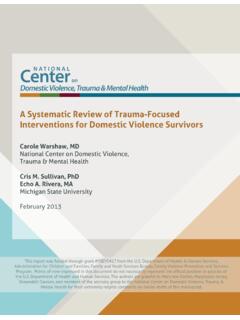Transcription of Batterer Intervention Programs - California
1 Batterer Intervention ProgramsCounty Probation Departments Could Improve Their Compliance With State Law, but Progress in Batterer Accountability Also Depends on the CourtsREPORT NUMBER 2005-130, NOvEMBER 2006 Five county probation departments responses as of November and December 2007 State law requires an individual who is placed on probation for a crime of domestic violence to complete a 52-week Batterer Intervention program (program) approved by a county probation department (department). The Programs are structured courses designed to stop the use of physical, psychological, or sexual abuse to gain or maintain control over a person such as a spouse or cohabitant. The Joint Legislative Audit Committee requested that the Bureau of State Audits examine the extent to which the various entities involved in Batterer Intervention including Programs , departments, and courts hold convicted batterers accountable. Specifically, we were asked to review how the departments and courts responded to a sample of progress reports, allegations, or other information from the Programs .
2 We were also asked to determine how well a sample of departments oversee #1: Many batterers do not complete their required Programs , and the extent to which they are held accountable on statistics provided by the departments and our review of a sample of 125 batterers, only about half of the batterers required to complete a program actually do so. In reviewing department responses to violations committed by the 125 batterers, we found that some departments we visited counseled and referred batterers back to Programs after they had been terminated for violations, rather than notifying the courts as required by state law. Because only two batterers in our sample ever completed a program after committing three or more violations, we questioned whether this practice only delays the inevitable court-imposed consequences of jail time or probation revocation. Further, some courts notified of violations simply returned batterers to Programs without imposing any additional jail time, even though at times the Batterer had multiple prior violations.
3 We questioned whether this practice may be sending the unintentional message to batterers that they can avoid the program requirement without any significant penalty for doing the most frequent violation involved noncompliance with attendance policies, the departments we reviewed had various policies regarding program attendance, and all were more lenient than statutory provisions, which allow for only three absences for good cause. In discussing their policies, departments cited the need for greater flexibility in attendance policies to allow as many batterers as possible to complete their assigned Programs . In addition, the counties of some of the departments we visited have implemented a practice of having batterers make regular appearances to have their progress reviewed by the court. This appears to provide for better Batterer accountability and may improve program outcomes. Audit Highlights ..Our review of Batterer Intervention Programs ( Programs ) in California revealed the following.
4 Only about half of batterers complete a program as required by state two batterers in our sample of 125 ever completed a program after committing three or more violations of their program or probation county probation departments (departments) we visited had various attendance policies, and all were more lenient than statutory provisions, which allow for only three absences for good than notifying the courts as required by state law, some departments are counseling and referring batterers back to Programs after they have been terminated for sometimes do not impose any consequences on batterers, even those with multiple prior program reviews required by statute are not being performed State Auditor Report 2008-406 February 2008We recommended that the departments, in conjunction with the courts and other interested county entities, jointly consider taking the following actions: Establish and clearly notify batterers of a set of graduated consequences that specify minimum penalties for violations of program requirements or probation terms.
5 The nature of the violation, as well as the number of previous violations, should be taken into consideration when establishing the consequences. As part of these graduated consequences, establish a limit to the number of violations they allow before a Batterer s probation is revoked and he or she is sentenced to jail or prison. Eliminate the practice of having probation officers counsel and direct batterers back to Programs in which they failed to enroll or from which they have been terminated for excessive absences, and establish a consistent practice of notifying the court of such violations, allowing the court to set the consequence for the violations. If they have not already done so, implement a practice of regular court appearances in which batterers receive both negative and positive feedback on program compliance. Require Programs to submit progress reports to the courts at the frequency specified by also recommended that the Legislature consider revising the attendance provisions included in the law to more closely align with what departments and courts indicate is a more reasonable standard and assess whether probation and the program requirement are an effective deterrent for future acts of domestic violence for individuals who commit acts of domestic violence while in Programs or after completing a County Probation Department s Action: Corrective action consideration of the report recommendations, the Butte department stated that it believes weekly pre-court and quarterly roundtable discussions among the judge, deputy district attorney, defense counsel, probation officers, and treatment program representatives help develop the consistency of consequences the audit report recommends.
6 The Butte department indicated that its batterers are brought before the court for any failure to abide by the treatment program. Recommendations related to progress reports and regular court appearances were not directed to the department in Butte County because we did not discover any deficiencies related to these areas at this department during the Angeles County Probation Department s Action: Partial corrective action its original response to the audit, the department in Los Angeles County, in consultation with the court in the county, indicated that it believes that the recommendation related to graduated consequences interferes with the discretion of individual judges and that regular court appearances would only be necessary for court-supervised probationers, not batterers on formal probation. We have not received any further communications from the county on this matter. Recommendations related to progress reports and court notifications of violations were not directed to the department in Los Angeles County because we did not discover any deficiencies related to these areas at this department during the County Probation Department s Action: Corrective action Riverside department provided us with an outline of the graduated consequences the court in the county has established to guide its bench officers in their handling of treatment program attendance and enrollment violations for misdemeanor domestic violence cases in the county.
7 Among other things, the outline indicates that on the fourth violation, probation will be terminated and the individual will serve extensive jail State Auditor Report 2008-406 February 2008228 The Riverside department explained that, because of an overburdened court system, the court is not able to have regular court appearances for all batterers and expects the probation department to attempt to resolve minor violations before returning the case to the court. Consequently, the department explained that it is in the process of implementing a policy in which probation officers could reinstate batterers into a program after a first-time attendance or enrollment violation but would provide written notification to the court of this action. The court could then choose to set the matter for further hearing if need be. The recommendation related to progress reports was not directed to the department in Riverside County because we did not discover any deficiencies related to this area at this department during the Joaquin County Probation Department s Action: Corrective action San Joaquin department stated that, although it was not able to obtain consensus from the court on a set of graduated consequences for batterers, it did develop a set of graduated consequences for its probation officers to follow in making recommendations to the court following violations of probation.
8 These consequences include a recommendation that a Batterer s probation be terminated, with all remaining jail time imposed, for the fourth violation of San Joaquin department stated that it has directed probation officers to refer batterers back to Programs only after a violation of probation has been filed with the court and the court has directed the Batterer back to the probation department. Due to the limited resources of the court, the department indicated that regular court appearances are not feasible at this time. Additionally, the San Joaquin department stated that the courts have requested that required progress reports from the Programs be sent to the department and the department has assumed the responsibility of notifying the court of any required Mateo County Probation Department s Action: original and subsequent responses from the San Mateo department did not indicate that it jointly considered the report s recommendations with the court and other interested county entities.
9 Rather, the department responded that to its knowledge the court has not established a set of graduated consequences but that it is confident that all probationers are consistently held accountable for probation violations. The department then added that its current practices related to notifying the court of violations and referring batterers back to Programs will continue as they are until they are changed. Recommendations related to progress reports and regular court appearances were not directed to the department in San Mateo County because we did not discover any deficiencies related to these areas at this department during the Action: #2: Some courts appear to be inappropriately sentencing batterers to anger management Programs that do not last 52 weeks and may not address domestic violence the course of our audit, department officials told us, and evidence we found at one county we visited confirmed, that courts were directing individuals placed on probation for crimes of domestic violence to 16-week anger management Programs , rather than the required 52-week Batterer Intervention Programs .
10 We also found one instance in Los Angeles County where the court delayed sentencing on an individual it found guilty of battery (the victim met the statutory definition of domestic violence contained in Family Code 6211) until 26 court-ordered program sessions could be completed. Then, after six months of delayed sentencing, it dismissed the charges in the furtherance of justice. We recommended that the courts consistently sentence, and the departments consistently direct, individuals granted probation for a crime of domestic violence when the victim is a person specified in Section 6211 of the Family Code to a 52-week Batterer Intervention program approved by the department. Courts should not substitute any other type of program, such as a 16-week anger management program, for a 52-week Batterer Intervention State Auditor Report 2008-406 February 2008 If it is the Legislature s intent that individuals who commit domestic violence be consistently sentenced to 52 weeks of Batterer Intervention , it should consider enacting statutory provisions that would not allow the courts to delay sentencing so that batterers can complete a lesser number of program Angeles County Probation Department s Action: its original and subsequent responses, the department in Los Angeles County provided no specific information from the court on this County Probation Department s Action.



















